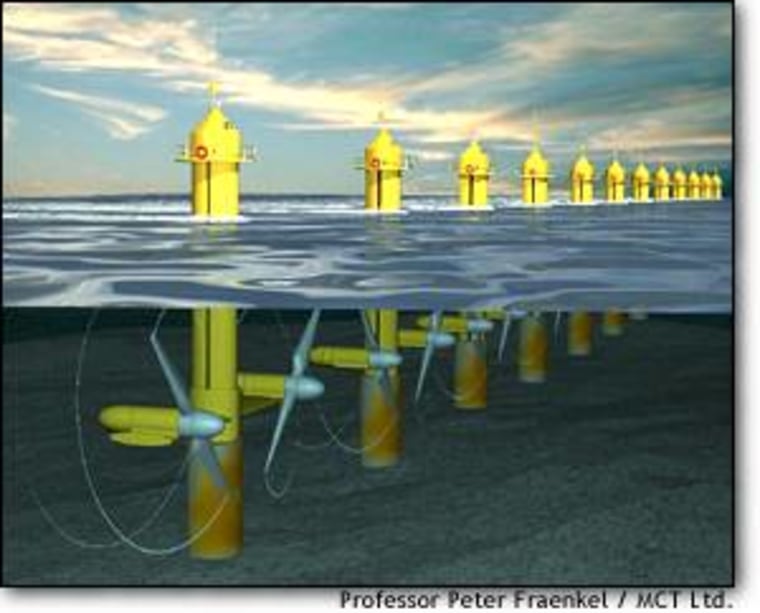When Ian Bryden gazes at the Pentland Firth, the roiling channel between Scotland’s northern coast and the Orkney Islands, he sees far more than a bustling shipping lane. Deep beneath the surface of those North Sea waters, Bryden says, is the answer to Britain’s future energy needs.
It may sound improbable, even fantastical, but Professor Bryden and his team of researchers at Aberdeen’s Robert Gordon University plan to sink 150-foot-tall propeller-driven turbines into the Pentland Firth over the next five years. The underwater windmills will rotate with the shifting sea currents, which frequently churn at more than 12 knots, delivering energy to the nation’s main power grid.
To prove his research, Bryden will begin small, with three to five turbines. If the initial work proves successful, the payoff could be staggering for a region where oil and gas supplies are dwindling.
“There’s more energy flowing through the Pentland Firth than from all the oil and gas in the world,” says Bryden gleefully.

The professor adds that the Pentland Firth’s waters alone could generate 30 gigawatts of power — enough to light all of Britain each year. That would involve thousands of turbines and closing down the Firth’s busy shipping lanes, admittedly an impossibility. But Bryden’s message is clear: Renewable power sources hold the key to solving many of the world’s energy crises.
In another corner of the North Sea, the tiny nation of Denmark has taken the lead in the development of wind power. Almost two decades since Denmark began harnessing the wind that whips across the peninsula nation, the country now gets 15 percent of its power from 2,300 turbines in coastal and rural areas.
Several years ago, the government began an experiment to see if parts of the country of 5.4 million could live off 100 percent renewable power.
Today, on the small island of Samso, 4,500 Danes are doing just that. Three years into a decade-long experiment, Samso’s residents power their lives with wind, solar and biomass — organic waste — and they do it at not much more than the cost of power provided by traditional utility companies. Solar panels are ubiquitous, and windmills and piles of biomass wood chips to fuel furnaces are a common sight in the backyards of Samso residents.
“Everybody has a responsibility to do something about their own energy consumption,” says project founder Soren Hermanson, a Samso native, who like a growing number of Danes, has seen his personal investment in windmills turn a profit.
The commitment to wind power has translated into a commercial success, with Denmark becoming a global leader in manufacturing wind turbines. Next year, Danish firms expect to take 60 percent of the world market, and the leading Danish producer, Vestas Wind System, has seen its stock soar 20 percent in the past year.
The Danes appear to be on the right track.
Schroeder Salomon Smith Barney, the investment bank, recently published a 450-page report called “The New Electric Economy,” which predicts that demand for growth for such “clean” power resources “should run at close to 20 percent in the medium term, driven by regulation and power shortages.”
So why hasn’t the United States, the world’s largest economy and biggest producer of greenhouse gas emissions, followed Europe’s example?
Environmentalists and experts cite a combination of factors. Geographically, Europeans have less land to play with than a country the size of the United States, and that means less room to hide massive coal-fired power plants that cough out heavy pollution.
Europe also has a deep tradition of institutional environmentalism and no shortage of “green” parties that push environmental agendas to the forefront of politics. Thirty years ago, Denmark was the first European country to appoint a cabinet-level environment minister. Its neighbors quickly followed suit.
While sales of gas-guzzling SUVs soar in the United States — even though they use more gas and Americans drive more and farther than most Europeans — compact and fuel-efficient cars are the norm across the Atlantic. In big cities in Holland and Denmark, more than a third of commuters bike to work.
Government-sponsored car-free days have caught on in many areas of the continent, where automobile makers and consumers — wary of $4-a-gallon gas prices — anticipate a big consumer demand for hybrid-fueled and electric cars.
Christine Real de Azua of the American Wind Energy Association calls the lack of a focused green policy in the United States “shortsightedness” on the part of the government.
“There hasn’t been steady and consistent policy supporting wind energy like there has in Europe,” says Real de Azua. “Public support for renewable energy is very high, but utility companies are taking a conservative approach.”
The development of renewable energy in general has been hurt by a lack of legislation to provide tax credits for energy producers to help minimize their financial risk, Real de Azua says.
The United States produces more than half of its power from coal-burning plants, and only .1 percent of its energy needs from wind, despite a potential for wind to supply 20 percent of the country’s energy needs, says Real de Azua. Denmark, in contrast, plans to meet half of its energy needs with wind by 2025. And Germany, Europe’s largest producer of wind power, aims to rely on it for a third of its energy needs.
In 2000, only 2 percent of the U.S. domestic energy demand came from renewable energy sources, according to Department of Energy statistics.
But there may be hope yet.
Real de Azua notes that Texas is set to become one of the leading wind power producers in the United States, following new legislation that requires utility companies to purchase a fixed percentage of their power from renewable sources. The law was signed in 1998 by then Texas Governor Bush.
Now president, Bush is promoting an energy policy that relies heavily on fossil fuels.
In Aberdeen, renewable energy prophet Bryden say it’s time for the United States to wake up to Europe’s green revolution.
“It’s bizarre, because the United States has the most to lose,” he says.
NBC’s Ron Allen contributed to this report.
